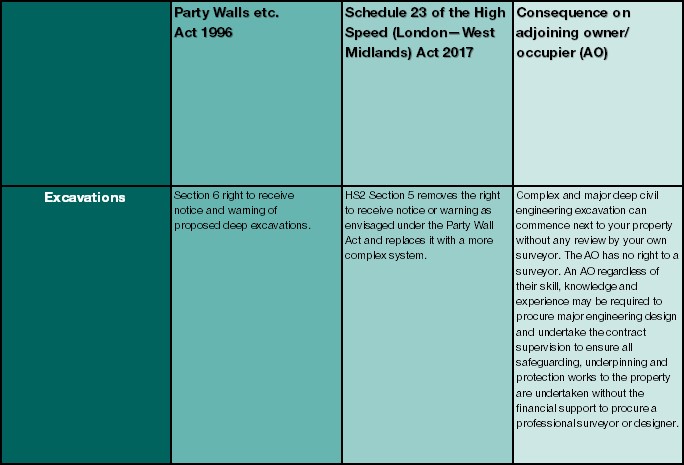
High Speed 2 alters the rights of owners and occupiers previously guaranteed under the Party Wall etc. 1996 Act
In property the most common shared feature is the party wall and across the country differing rules once existed to deal with the administration of these jointly held elements of a building. The attractiveness of having a uniform system of administration for all party walls took a long time to be established as a concept. This did not finally take place across England and Wales until the introduction of the Party Wall etc. Act 1996.
At the heart of the Party Wall etc. Act 1996 is the desire to seek balance in the reasonable rights and expectations of both building and adjoining owner. Both the current and historic London Building legislation seek to ensure fairness and ensure that an adjoining owner is protected from unnecessary inconvenience both as an express term but also in ensuring that a system of warning via notices are given to avoid unwelcome surprises. What reasonable owner would like an army of workmen appearing on their land and in their building as a legal right with zero warning or any prior announcement?
Overall, the property rights established under the Party Wall etc. Act 1996 have remained unchallenged until the needs of major infrastructure projects started to be planned. The Crossrail Act 2008 Schedule 14 Paragraph 17 made the first adjustments to the legislative balance between owners. In this first adjustment the Nominated Undertaker was freed of the obligations of the service of notice, however, in balance no right was granted to override the common law position. The adjustment was minor and limited to three clauses, with the effect of replacing one statutory process with the other when the infrastructure project was the neighbour.
Imbalance created by HS2
Now that the intention to proceed with High Speed Rail 2 has been confirmed, the practical implications of schedule 23 of the High Speed Rail (London – West Midlands) Act 2017 deserves closer examination. A property manager holding an asset likely to be affected by this legislation must grapple with the significant impact this will have on property ownership rights. The usual assumptions that are held under the traditional party wall process have been fundamentally changed as to be almost unrecognisable.

This will impact both the landlord and tenant interests in the asset both as the adjoining owner and occupier. The imbalance within the High Speed Rail legislation and the scale of adjustment of rights towards the nominated undertaker cannot be stressed enough. The administration of the whole process should not be confused with a standard party wall situation.
Property managers should consider taking specialist legal advice and consider appeal to county courts where their clients are likely to be impacted by party wall or excavation works due to High Speed Rail and the reason for this is explained in figure 1, which sets out some of the fundamental adjustments created by Schedule 23 of the High Speed Rail (London – West Midlands) Act 2017.

Complex and confused
The alternative HS2 system is complex, confused and in need of judicial determination to provide clarity. The drafting changes have destroyed the representation and balance within the original legislation. Rather than seeking to balance the reasonable concerns of a property owner finding themselves located next to a major infrastructure project the focus has been aimed at removing protection and safeguard.

The removal of representation and balance within the HS2 approach is likely to generate increased claims and disputes.
The project will not commence with a jointly agreed schedule of condition prepared by the two surveyors. This will lead to disputes over reinstatement and damages. Owners, rather than seeking experienced chartered building surveyors with a background in party wall matters, are likely to gravitate towards claim management companies. This claim approach will lead to more complex arbitrations, increased costs and greater need for parties to seek the protection of the courts.

Increased risk to adjoining owner
Major excavation works typically require safeguarding and protection works from the building owner. Under the Party Wall etc. Act 1996, that safeguarding cost clearly falls to them to administer the cost in full, both during the primary works but also in the event of movement damage. The shift in emphasis placing this complex procurement decision making of major engineering safeguards on to the adjoining owner is potentially fraught with difficulties.
This is the foundation not only of potential dispute but is a fundamental failure in drafting to consider construction safety. CDM 2015 created an industry culture of skill, knowledge and experience and should be adhered to. Temporary works on this large-scale project are a high-risk element of the project works that the HS2 design team, in seeking this legislative route, cannot ignore.

Interestingly, in the adjustment to the original legislative drafting some useful safeguards were maintained. The adjoining owner still has the right to seek security of expenses under section 12(1) and this notice should be served to ensure that any section 13(1) funds are ringfenced at the earliest opportunity. This will also allow the dispute and calculation of safeguarding costs to be had before the expenditure of potentially major sums of adjoining owner capital.
We, the authors, feel that the adjustments to the tried and tested party wall legislation, while favouring the speedy delivery of this major scheme, have overlooked the fundamental principles of the party wall legislation of safeguarding owners and protecting property. Surely the only adjustment required to speed this well-regarded project along would be forethought and planning of the consequences and mitigation measures in the implementation of the design before it approaches the neighbouring land and property. There is plenty of time, why the hurry?

Further information on High Speed 2 safeguarding for developers and local authorities can be found here.
